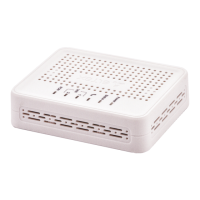____________________________________________________________________________________
____________________________________________________________________________________
50 NTU Optical Network Terminals
– Username—user name for the DDNS account;
– Password—password for the DDNS account;
– DynDNS Type—select the type of the service registered at the provider:
– Dynamic—Dynamic DNS service registered;
– Static—Static DNS service registered;
– Custom—Custom DNS service registered;
– Wildcard—when checked, a special DNS record is used which is responsible for all subdomains and
corresponds to any request to a non-existing domain name. It is indicated as * in the subdomain field,
for example *.domain.tld.
– Email—email used for authentication;
– Key—DDNS account key.
Click the Apply/Save button to accept and save the changes.
4.2.7 Print Server menu
1
. Print Server Configuration
The print server is a software or hardware solution that allows users of wired or wireless networks to
share a printer at home or at an office. The printer is completely independent from network computers and
decreases the load on the user’s working environment. Besides, the print server establishes continuous
communication to the printer, AIO, scanner, and other office machines located in the LAN.
– Enable on-board print server—when checked, the print server is enabled, otherwise it is disabled;
– Printer name—name of the printer;
– Make and model—manufacturer and model of the printer.
To accept and save the settings, click the Apply/Save button.
4.2.8 UPnP menu. Automatic setup of Network Devices
Use the menu to configure Universal Plug and Play (UPnP™). UPnP ensures compatibility with network
equipment, software and peripheral devices.
1
Only for NTU-2W, NTU-RG-1402G-W

